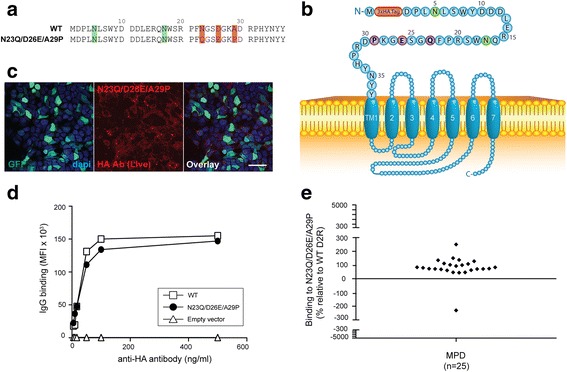Fig. 6.

Patient antibody recognise mouse D2R when N23 is deglycosylated. a Amino acid sequences of extracellular 37 amino acids of N23Q/D26E/A29P and WT D2R. Green = putative N-glycosylation sites; Red = amino acid changes. b Schematic of N23Q/D26E/A29P at cell surface. Red = 3xHA tag; Green = N-glycosylation site; Blue = D2R sequence; Purple = point mutation. c Confocal images after live immunolabeling of N23Q/D26E/A29P- transfected HEK293 cells using an anti-HA antibody (scale bar = 50 μm). d Similar cell surface expression of N23Q/D26E/A29P and WT D2R constructs was confirmed by flow cytometry on live cells. No D2R expression from empty vector was observed. Representative data out of three independent experiments is shown. e Sera from anti-D2R antibody-positive movement and psychiatric disorders (MPD, n = 25) were incubated with empty vector-, WT D2R -, and N23Q/D26E/A29P-transfected live HEK293 cells at 1:50 dilution, followed by AF647-conjugated anti-human IgG secondary antibody, and flow cytometry analysis. Percentage of sera binding to N23Q/D26E/A29P (MFI %) was calculated using the formula described in Material and Methods. 96% patients (24/25) recognized N23Q/D26E/A29P, whereas 4% (1/25) showed no immunoreactivity to N23Q/D26E/A29P. Binding threshold is represented by solid line on graph. Representative data out of three experiments is shown
